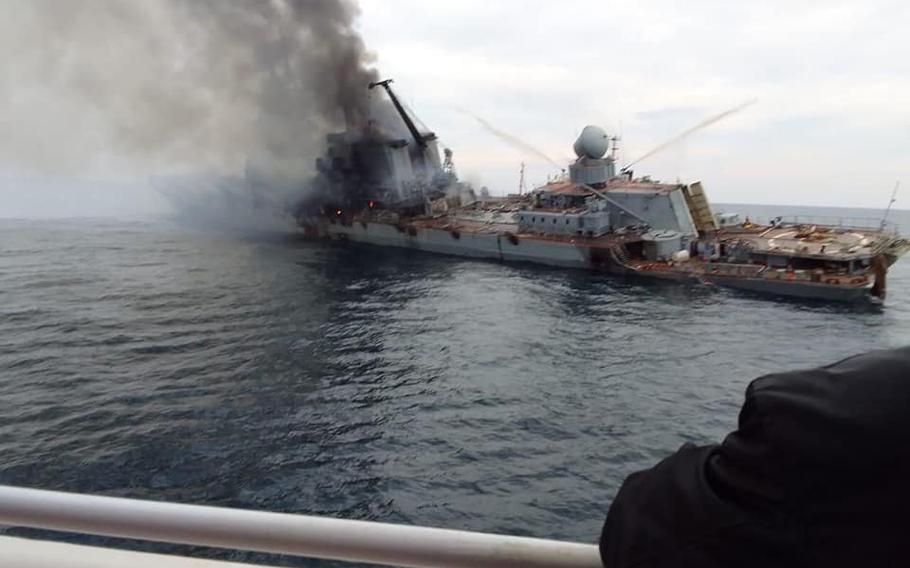
Sea state
Moskva, the Russian Navy’s Black Sea flagship, sank near the port of Odessa in southern Ukraine last week. Amid conflicting reports from Kyiv and Moscow, the US has backed claims that an RK-360 Neptune anti-ship cruise missile strike by Ukrainian forces caused the cruiser vessel to sink. For Russia, the loss of the Moskva signifies ‘a blow to the prestige of the Russian armed forces’ and is a major setback for its naval capabilities in the Black Sea and its ability to support any operations against the strategically critical port of Odessa.
Meanwhile, in Australia, the government has dropped its pledge to build a Pacific support ship in favour of purchasing an existing vessel from overseas. The five-year-old, Norwegian-built offshore supply ship Horizon Star cost $93 million and has been renamed Australian Defence Vessel Reliant. The decision represents a missed opportunity for Australian defence industry, though the government has pledged a similar amount for two new Cape-class patrol boats to be built by Western Australia-based company Austal. Together, these acquisitions represent commitments to increased engagement in border control and disaster relief initiatives.
Flight path
Defence Minister Peter Dutton has announced an acceleration of Australia’s long-range missile acquisition plan worth $3.5 billion. The JASSM-ER (joint air-to-surface standoff missile—extended range) will be acquired for the FA-18F Super Hornets, and the NSM (naval strike missile) for the Anzac-class frigates and Hobart-class destroyers. The expedited timeline is to deter acts of aggression amid Indo-Pacific concerns. While the three-year acceleration will ensure Australia has long-range weapons by 2024, the JASSM-ER will only partially fill the gap created by the retirement of the Classic Hornet, which was the only RAAF aircraft that could launch the earlier JASSM.
A New Zealand Defence Force C-130H Hercules and 50 personnel arrived at RAF Brize Norton in the UK on Monday. The Hercules will join a fleet of aircraft flying between countries in Europe, transporting military and humanitarian aid to destinations from which it can be taken into Ukraine by land. So far, New Zealand has deployed 67 staff and contributed NZ$30 million for support, weapons procurement and satellite access. The NZ government has been under pressure to supply military hardware to Ukraine, but it argues that this new commitment is a proportionate response to a blatant attack on a sovereign country.
Rapid fire
In what is perhaps the key strategic shift since Russia launched its invasion of Ukraine, the war has pivoted from an unsuccessful assault on Kyiv to the so-called Battle of the Donbas, a large-scale Russian offensive stretching across a 500-kilometre front in Ukraine’s east. This new strategy has so far achieved a valuable Russian objective, with the governor of the eastern city of Kreminna reporting the Russian ‘orcs’ have captured it. However, both military experts and Ukrainian leaders remain optimistic that the Russian offensive ‘will likely fail’ due to logistical vulnerabilities and strong Ukrainian opposition.
The strength of Ukraine’s resistance under President Volodymyr Zelensky has exceeded expectations, in large part due to the military equipment supplied to Ukrainian forces by NATO and allied nations. There are also reports that British special forces have travelled to Ukraine to instruct recruits in the use of anti-tank missiles such as NLAWs (next-generation light anti-tank weapons), which have been used to devastating effect against Russian armoured vehicles.
Final frontier
The US government has announced that it will bar American testing of anti-satellite missiles. So-called kinetic-kill anti-satellite weapons have become a more urgent issue following Russia’s use of a missile to destroy a defunct Soviet-era satellite in November last year, which created space debris that increased the risk to astronauts and space assets. While it’s unclear whether other nations will follow the US lead, the new ban is a concerted attempt to establish new norms for military action in space.
The US Air Force Research Laboratory and L3Harris will begin integration testing of Navigation Technology Satellite-3 (NTS-3) in the middle of the year. The NTS-3 is designed to detect and mitigate interference to position, navigation and timing technology in geosynchronous orbit. It could become a geographically focused capability as it matches the earth’s rotation, unlike GPS satellites in medium-earth orbit. If testing is successful, the NTS-3 could strengthen the robustness of satellite navigation technology used by the US military.
Wired watchtower
The Australian Electoral Commission is seeking to counter disinformation about electoral fraud spreading on social media during the election campaign, including from minor-party candidates. While there have so far been no claims outlining exactly how the election would be rigged, the AEC is monitoring growing voter-fraud rhetoric being ‘imported’ from the US, where baseless claims about election fraud were peddled during the 2020 election. In response to the AEC’s request, Facebook has taken down at least two pages and five posts.
Chinese-owned social media app TikTok has reportedly created an alternate universe just for Russians. In early March, in response to the country’s new law that criminalised ‘fake news’ about Russia’s military, TikTok initially blocked all new posts from Russia and banned Russian users from seeing content originating outside of Russia. However, a report revealed a loophole in the content restrictions that allowed a coordinated network of pro-war propaganda to appear in Russian TikTok feeds until 26 March. The discovery has sparked concerns about the level of TikTok’s autonomy from Beijing, which has pledged to strengthen ties with Russia amid its invasion of Ukraine.